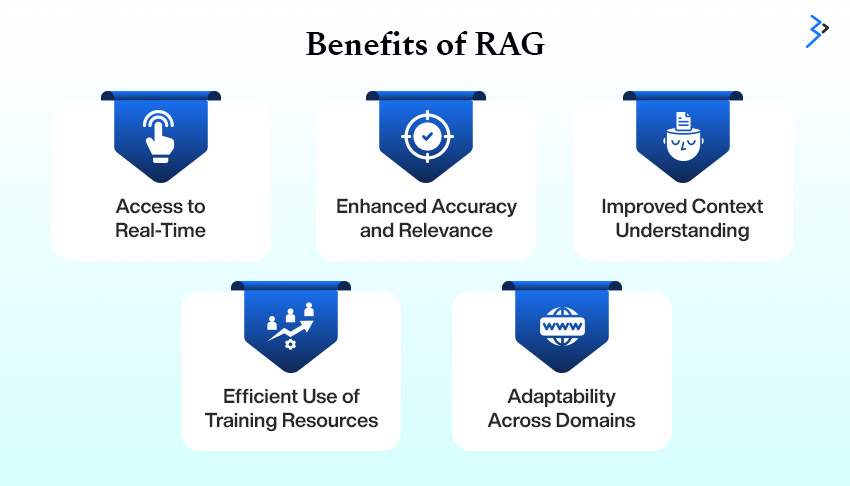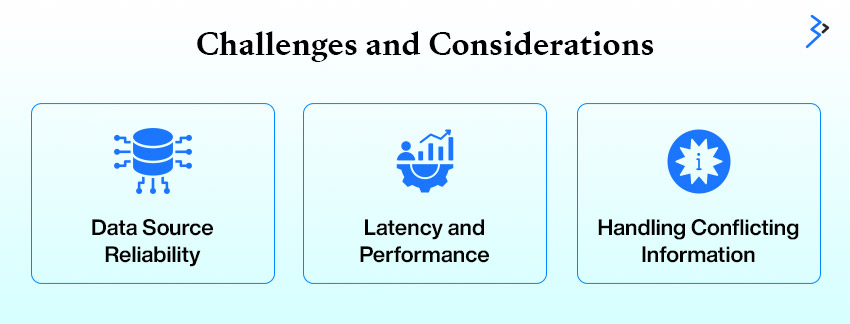Table of contents
What is Retrieval-Augmented Generation (RAG)?
Benefits of RAG
Real-World Applications of RAG
Building RAG-Powered Solutions with Azure Cognitive Search and LangChain
Challenges and Considerations
Future of RAG and LLMs
Final Thoughts!
The rapid advancement of Large Language Models (LLMs) like GPT-4 has revolutionized how we interact with AI.
Imagine a seasoned chef running a busy restaurant. The chef can cook various dishes from memory — classic pasta, rich stews, or delicate desserts. But when a guest requests a rare regional specialty or a dish from a centuries-old recipe, the chef sends a sous-chef to the cookbook archives to find the exact details.
Large language models (LLMs) work similarly: they can generate answers on countless topics based on what they’ve learned. But when accuracy and depth are crucial — like citing medical studies or technical specifications — they need help finding the right “recipe.”
This is where retrieval-augmented generation (RAG) steps in. It acts like the sous-chef, fetching precise information from trusted sources to enrich the model’s response.
LLMs have proven their potential, generating human-like text and assisting with complex problem-solving. However, they still face limitations, particularly when accessing the latest information or handling domain-specific knowledge. This is where Retrieval-Augmented Generation (RAG) steps in, offering a game-changing approach to making LLMs more intelligent, accurate, and contextually aware.
Let’s examine RAG, how it works, and why it’s essential for enhancing modern AI systems.
What is Retrieval-Augmented Generation (RAG)?
Retrieval-augmented generation (RAG) is an advanced technique that enhances language models by combining generative capabilities with real-time retrieval of external data sources. Unlike traditional LLMs that rely solely on pre-trained knowledge, RAG-equipped models dynamically fetch relevant, up-to-date information from knowledge bases, documents, or databases during the generation process.
For example, imagine asking an AI for the latest stock market trends or a technical explanation of a newly published scientific paper. A standard LLM may provide outdated or generic information based on its training data. In contrast, a RAG-powered model retrieves current data from reliable sources and integrates that information into its response, producing more accurate and contextually relevant output.
How RAG Works
RAG operates through two key components: retrieval and generation.
1) Retrieval Phase:
- When a user inputs a query, the RAG system searches an external data source (e.g., a document repository, API, or knowledge base) to retrieve the most relevant information.
- Tools like Azure Cognitive Search or LangChain’s document retrieval pipelines make this process fast and efficient.
2) Generation Phase:
- The retrieved data is then fed into the LLM, which synthesizes the information and generates a response that seamlessly blends the model’s pre-trained knowledge with the newly fetched data.
- This dynamic retrieval-and-generation loop ensures the AI remains current, contextually aware, and capable of handling specialized queries beyond its original training set.
Benefits of RAG

Retrieval Augmented Generation (RAG) combines the strengths of pre-trained language models with real-time information retrieval, creating a powerful hybrid approach. This innovation transforms how generative AI development company responses — making them more accurate, relevant, and adaptable. Let’s dive into the key benefits:
1. Access to Real-Time, Domain-Specific Knowledge
Traditional language models rely on static training data, which can quickly become outdated or may not cover niche topics. RAG bridges this gap by retrieving current, domain-specific information as needed, ensuring the AI stays relevant and informed.
- Live data integration: Pulls the latest information from trusted sources.
- Domain-specific retrieval: Provides specialized insights tailored to industries like healthcare, law, or finance.
- Future-proof AI: Reduces the risk of outdated answers in fast-evolving fields.
2. Enhanced Accuracy and Relevance
Large language models sometimes "hallucinate" — generating plausible but false or misleading information. RAG helps prevent this by injecting fact-based data directly into the generation process.
- Fact-checked responses: Supports AI outputs with verifiable, external data.
- Reduces misinformation: Limits errors and ensures more trustworthy content.
- Refined outputs: Delivers responses grounded in reliable sources, improving precision.
3. Improved Context Understanding
RAG goes beyond surface-level comprehension by enriching language models with external context. This depth helps the AI interpret complex queries more accurately — especially in technical or industry-specific situations.
- Deeper insights: Pulls relevant documents to provide more nuanced, informed answers.
- Adaptive context: Handles multi-part questions or layered topics with ease.
- Industry-savvy AI: Supports specialized fields with greater contextual awareness.
4. Efficient Use of Training Resources
Training large models on massive datasets requires time, computing power, and money — especially when retraining is necessary to stay up-to-date. RAG minimizes this need by allowing the model to retrieve current information without requiring a full retrain.
- Cost-effective updates: Reduces expenses tied to frequent retraining.
- Faster deployment: Speeds up the time it takes to bring updated models to production.
- Sustainable scaling: Supports larger datasets without bloating training times.
5. Adaptability Across Domains
RAG’s dynamic retrieval capabilities make it a versatile tool for a wide range of industries. Whether it’s generating legal analysis, medical advice, or financial insights, the model adapts seamlessly to different domains — enhancing the user experience with field-specific expertise.
- Cross-industry flexibility: Supports diverse fields like healthcare, finance, law, engineering, and more.
- Customizable knowledge sources: Pulls from industry-relevant databases, research papers, or proprietary data.
- Personalized AI experiences: It tailors outputs to match the context and language of specialized sectors.
Real-World Applications of RAG

RAG isn’t just a promising concept — it’s already driving innovation across industries. By combining powerful language models with live information retrieval, RAG delivers smarter, more informed outputs tailored to specialized needs. Let’s explore how it’s making a difference in key sectors:
1. Customer Support and Knowledge Bases
Modern customer support relies on fast, accurate, and personalized responses — and RAG makes that possible. Companies like Microsoft integrate RAG with Azure Cognitive Search and OpenAI models to create intelligent virtual assistants that stay updated with the latest product information.
- Instant troubleshooting: Pulls real-time FAQs and support guides for faster issue resolution.
- Personalized interactions: Retrieves user-specific data to offer tailored support.
- Always current: Ensures accurate and up-to-date product details, policies, and solutions.
2. Legal and Compliance Analysis
The legal world runs on precision and thorough research. RAG empowers law firms, compliance teams, and corporate legal departments by fetching and analyzing regulatory documents, case laws, and policy changes on demand.
- Real-time legal insights: Retrieves current rulings and regulations for accurate case preparation.
- Policy comparison: Analyzes complex policies to find discrepancies and compliance risks.
- Enhanced due diligence: Supports faster, data-driven decision-making for legal teams.
3. Scientific Research and Healthcare
Healthcare professionals and researchers rely on the latest data to guide decisions. RAG helps by fetching cutting-edge research papers, clinical trial data, and treatment guidelines — streamlining diagnostics, drug development, and patient care.
- Accelerated research: Retrieves up-to-date scientific findings for quicker analysis.
- Informed diagnoses: Supports doctors with data on emerging treatments and conditions.
- Evidence-based recommendations: Enhances care plans with verified medical insights.
4. Financial Services
In the fast-paced world of finance, timing is everything. RAG-powered systems help financial analysts stay ahead by pulling live data from market reports, earnings releases, and economic forecasts — enabling smarter, faster decision-making.
- Market trend analysis: Pulls the latest market movements for real-time insights.
- Risk assessment: Retrieves financial reports to analyze performance and risks.
- Investment intelligence: Supports personalized portfolio strategies with live data.
5. E-commerce and Product Recommendations
RAG is revolutionizing e-commerce by enhancing how platforms recommend products. By retrieving live pricing data, customer reviews, and stock availability, it helps customers make faster, more informed decisions — boosting both engagement and sales.
- Personalized recommendations: Adapt suggestions based on live pricing and reviews.
- Competitive pricing analysis: Pulls competitor data to inform pricing strategies.
- Enhanced shopping experience: Ensures product listings stay fresh and accurate.
Building RAG-Powered Solutions with Azure Cognitive Search and LangChain

Let’s briefly explore two powerful tools driving RAG implementations: Microsoft’s Azure Cognitive Search and LangChain.
Azure Cognitive Search + OpenAI
Azure Cognitive Search acts as a high-performance retrieval engine, enabling RAG models to access structured and unstructured data across various sources. When integrated with OpenAI models, this combination delivers context-aware, data-enriched responses — perfect for knowledge-heavy industries.
Key Features:
- Intelligent document indexing and retrieval
- Scalable data pipelines
- Seamless integration with OpenAI’s generative models
LangChain for RAG
LangChain is an open-source framework for building data-aware and agent-driven applications using LLMs. It provides pre-built RAG pipelines, making connecting LLMs to external data sources and customizing retrieval logic easier.
Key Features:
- Easy-to-implement RAG architecture
- Flexible document retrieval methods
- Supports multiple data types and APIs
Challenges and Considerations

While RAG offers remarkable improvements, it’s not without challenges. Let’s explore some key considerations:
1. Data Source Reliability
The accuracy of RAG outputs depends on the quality and reliability of external data sources. Ensuring data integrity is crucial.
2. Latency and Performance
Real-time data retrieval may introduce latency, especially with large datasets or slow APIs. Optimizing retrieval speed is vital for responsive applications.
3. Handling Conflicting Information
When multiple sources provide contradictory data, RAG models must intelligently prioritize reliable sources to avoid confusing or inaccurate outputs.
Future of RAG and LLMs
RAG represents a pivotal shift in approaching AI models — blending generative prowess with dynamic data retrieval. As this technology evolves, we can expect:
- Deeper industry-specific integrations for highly specialized domains.
- Enhanced multimodal RAG models capable of retrieving text, images, audio, and video data.
- Smarter retrieval algorithms to improve speed, accuracy, and context comprehension.
With companies like Microsoft, OpenAI, and LangChain leading the charge, the future of RAG looks promising. It’s redefining AI capabilities, ensuring language models stay accurate, adaptable, and more useful than ever.
Final Thoughts!
Retrieval-augmented generation (RAG) is revolutionizing LLMs by providing them with real-time, domain-specific data, boosting accuracy, context awareness, and adaptability. RAG unlocks new possibilities across industries, from customer support and healthcare to financial services and research.
As RAG technology matures, it holds the potential to reshape AI, bridging the gap between static training data and the ever-evolving world of information. Whether you’re a developer, business leader, or tech enthusiast, embracing RAG could be the key to building more competent, more reliable AI systems.
Are you ready to take your AI capabilities to the next level with RAG?
Related Articles
Digital Transformation
Leveraging 3rd Party LLMs: A Guide to Commercial AI Platforms
Digital Transformation
Open LLMs: Unlocking the Power of AI-Language for Everyone
Digital Transformation
Exploring Generative AI’s Revolutionary Impact In Automotive Industry


